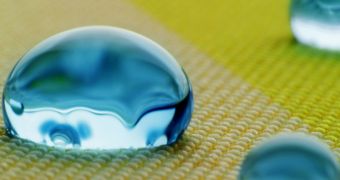Wouldn't it be wonderful if clothes washed themselves and the dirt on the kitchen floor simply disappeared? Don't lose hope, there may still be a way to do so! US researchers have recently shown that active enzymes similar to those contained inside biological clothing detergents could be used to coat surfaces so that any stains be simply 'eaten' away.
The process used by them to coat plastic surfaces with active enzymes is based on the spin coating technique used to cover CDs or DVDs with thin plastic protective layers. The surface is placed on a high speed rotating rig. Then a large drop of coating it placed on the surface and the spin cycle may begin. As the coating material is spun along the surface, centrifugal forces push it towards the outer layers, covering the whole area and ejecting any unnecessary excess.
The spin also allows part of the coating liquid to evaporate and form a thin solid film. The film thickness depends on the rotation speed and the viscosity of the coating liquid. University of Minnesota researcher Ping Wang used in his experiment a disc measuring 10 centimeters across, which he coated in a layer of four films.
The first of the layered films was a polystyrene compound modified to bind to enzymes; then came a protein-digesting enzyme called subtilisin Carlsberg, used in everyday life for biological washing. After the enzyme was added the team layered a glutaraldehyde film so that the enzymes could tie to the plastic. Another subtilisin Carlsberg film ensured that the coating process was complete.
"The bonding between the enzyme and the polymer coating is as strong as the chemical bonds that are responsible for the integrity of plastics", said Wang while explaining that harsh chemical treating cannot destroy the enzyme protection. In spite of that, the enzymes are active enough to dissolve proteins as soon as stains occur.
"Our preliminary results showed that enzymes can be spin-coated onto any pre-prepared plastic structures and, beyond that, probably inorganic structure such as metals and ceramics", Wang added.
Additionally, spin coated enzymes may be used to create self-healing materials, or to produce multifunctional materials by coating them with a wider range of enzymes. "Functional structures such as these are going mainstream, and are continuously elucidating their great promise to the biomedical sciences, says Suwan Jayasinghe, biophysicist at the University College London.

 14 DAY TRIAL //
14 DAY TRIAL //